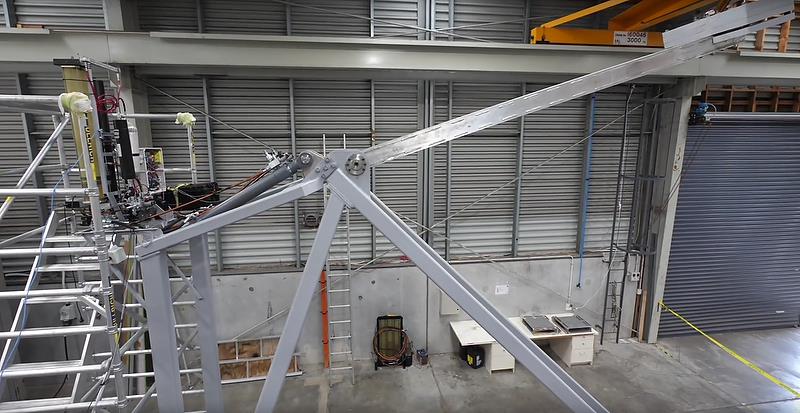
America's Cup: Teams get first look at the AC75 foiling mechanism
by Emirates Team NZ/Sail-World NZ 18 Feb 2019 23:20 PST
19 February 2019

The arm in the raised position with - Canting mechanism tested - Emirates Team New Zealand - Seotember 10, 2018 © Emirates Team NZ
Less than a year since the Class Rule publication, a first hint of the real scale of the AC75 boats has been given to each challenger representative during a number of visits to Auckland to witness the one design foil cant system (FCS) in action.
The electronically controlled hydraulic foil cant system controls the composite foil arms and wings for stability, lift and speed while racing. The maximum draft of an AC75 is 5metres, the length of the arm itself is approximately 4metres.
The FCS system will be supplied to each team in the 36th America’s Cup and its development has been led by Project Manager Peter ‘Brush’ Thomas, who took the unfamiliar step of showing the design and operational detail of one of the most integral systems on the AC75 to the other teams.
The wings themselves are free design within a dimension template, and are allowed to twist and rotate only ie they can't reduce in size once foiling to reduce drag in the way that a jet fighter's wing often does.
“It’s not something you normally do in the America’s Cup but the main objective of the whole project is for the system to be reliable and safe for every AC75 on the water,” said Thomas.
“These boats will reach very high speeds and when going into a manoeuvre they need the system to work. Each team must be sure that when they hit the button and they want to drop the foil it drops, when they want to raise the foil, it raises.
"Although teams have seen schematics on paper, this was the first opportunity for each challenger to see first-hand how the foil cant system works.”
First impressions were drawn to the sheer scale and size of the test foil arm and functionality of the control system which will be reflected on the spectacular AC75’s.
Dimitri Despierre of NYYC American Magic: “The scale of the AC75 is for sure something that people have no idea about. You can only realise this when you see it first-hand. It’s impressive and the work that has been done is no less impressive. We can’t wait to have our boat assembled and to start racing.”
Davy Moyon from Luna Rossa Challenge said: “It’s pretty impressive to see a 4 metre arm with a ton of weight at the end moving so fast. I’m glad we did a one design system. It will make the boats much safer as this is a key component and we can’t afford the teams to choose, for example, weight over safety.”
Jonathan Nicols representing INEOS Team UK: “They’ve done a good job in thinking what all the teams need and how the system will fit in the boat. It’s the first tangible example that shows the size of these boats. It’s all about going big and going fast!”
The development of the Class Rule was driven by safety and containing costs on certain aspects of the AC75, while leaving the rule open enough for the America’s Cup to continue as the driving force of innovation and technology in sailing.
The America’s Cup is about high-performance sailing, cutting-edge design and technology and the 36th America’s Cup will be no exception.
To have a further look inside the foil cant system, have a look again at the video posted few months ago by Emirates Team New Zealand.